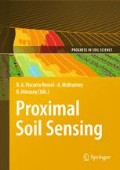Abstract
Thanks to recent technological developments, apparent soil electrical conductivity (ECa) can now be mapped over large areas, providing new data for precision agriculture. However, in Mediterranean vineyards, rooting depth can be greater than usual and the volume of soil that needs to be explored is greater. This study examined two vineyard blocks in southern France and looked at the ability of an ECa map, derived from a commercial mobile EMI system, to predict water-related vineyard variability [defined by variation in a normalised difference vegetation index (NDVI) map of the canopy]. To validate the ECa–canopy relationship, electrical resistivity tomography (ERT) profiles and soil observations (42 soil cores sampled to 4 m depth) were made over seven representative transects across the two blocks. In one of the blocks, the ECa map and the NDVI map were correlated, whereas only weak correlations were found for the other block. The examination of ERT data and soil observations in the first block showed a clear relation between soil electrical properties and soil properties known to influence vine water supply (e.g. bedrock depth) and a good discrimination of ERT measures at the measurement depth explored by EM38. In contrast, the second block showed lower ERT measurements and they were not directly related to any soil property that could cause variations in plant water. The contrasting responses between the two blocks demonstrate, as a prerequisite to ECa survey, the importance of prior and local knowledge of soil patterns.
Access this chapter
Tax calculation will be finalised at checkout
Purchases are for personal use only
References
Corwin DL, Lesch SM (2005) Apparent soil electrical conductivity measurements in agriculture. Comput Electron Agric 46:11–43
Dabas M, Tabbagh A (2003) A comparison of EMI and DC methods used in soil mapping – theoretical considerations for precision agriculture. In: Stafford J, Werner A (eds) Precision agriculture. Wageningen Academic Publishers, Wageningen, pp 121–127
Falipou P, Legros JP (2002) Le système STIPA-2000 d’entrée et édition des données pour la banque nationale de sols DONESOL II. Etude et Gestion des Sols 9:55–70 (in French)
Lamb DW, Mitchell A, Hyde G (2005) Vineyard trellising with steel posts distorts data from EM soil surveys. Aust J Grape Wine Res 11:24–32
Loke MH (2002) Tutorial: 2D and 3D electrical imaging surveys. Technical note, 2nd edn. Malaysia
McKenzie D (2000) Soil survey options prior to vineyard design. Aust Grapegrower Winemaker Annu Tech Issue 438a:144–151.
Samouëlian A, Cousin I, Tabbagh A, Bruand A, Richard G (2005) Electrical resistivity survey in soil science: a review. Soil Till Res 83:173–193
Sudduth KA, Drummond ST, Kitchen NR (2001) Accuracy issues in electromagnetic induction sensing of soil electrical conductivity for precision agriculture. Comput Electron Agric 31: 239–264
Sudduth KA, Kitchen NR, Bollero GA, Bullock DG, Wiebold WJ (2003) Comparison of electromagnetic induction and direct sensing of soil electrical conductivity. Agron J 95:472–482
Taylor J, Tisseyre B, Praat J-P (2005) Bottling good information: mixing tradition and technology in vineyards. Frutic ’05 symposium, Montpellier, France, Sept 12–16
Telford WM, Geldart LP, Sheriff RE (1990) Applied geophysics, 2nd edn. Cambridge University Press, Cambridge
Visser H, de Nijs T (2006) The map comparison kit. Environ Model Software 21:346–358
Acknowledgement
This experiment was carried out in the ‘Pech Rouge’ vineyards of the INRA experimental laboratory and was undertaken within the program ‘Institut Languedocien de l’Eau et de l’Environnement’. We thank particularly Mr. O. Huttel for his help in ERT measurements and data inversion and J.L. Belotti for his help in soil sampling. The authors thank J. Taylor for assisting with the English as well as improving comments and analysis of our results.
Author information
Authors and Affiliations
Corresponding author
Editor information
Editors and Affiliations
Rights and permissions
Copyright information
© 2010 Springer Science+Business Media B.V.
About this chapter
Cite this chapter
Coulouma, G., Tisseyre, B., Lagacherie, P. (2010). Is a Systematic Two-Dimensional EMI Soil Survey Always Relevant for Vineyard Production Management? A Test on Two Pedologically Contrasting Mediterranean Vineyards. In: Viscarra Rossel, R., McBratney, A., Minasny, B. (eds) Proximal Soil Sensing. Progress in Soil Science. Springer, Dordrecht. https://doi.org/10.1007/978-90-481-8859-8_24
Download citation
DOI: https://doi.org/10.1007/978-90-481-8859-8_24
Published:
Publisher Name: Springer, Dordrecht
Print ISBN: 978-90-481-8858-1
Online ISBN: 978-90-481-8859-8
eBook Packages: Earth and Environmental ScienceEarth and Environmental Science (R0)

